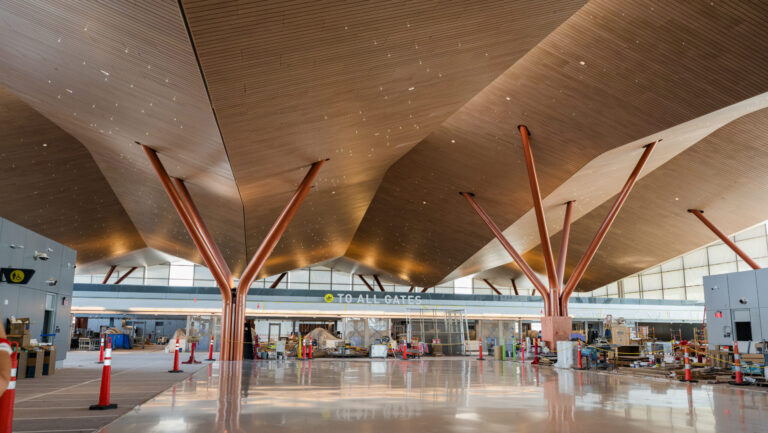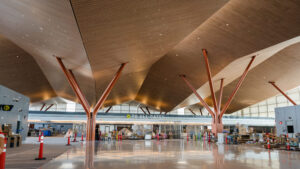The Terminal Modernization Program at Pittsburgh International Airport offers a lesson in how to build efficiently—and invest in Pennsylvania’s own workforce.
When Pittsburgh builds, we build with purpose. The new terminal at Pittsburgh International Airport isn’t just an investment in infrastructure—it’s a statement about who we are: practical, skilled, and proud to put our own people to work.
Airports aren’t just buildings; they’re how a region stays connected to opportunity. For families greeting loved ones, small businesses shipping samples, or students catching a flight to their first job interview, an airport is a front door and a promise. That’s why Pittsburgh International Airport’s Terminal Modernization Program (TMP) matters. It shows what happens when we invest in our own people and put common sense to work: we build something that reflects Western Pennsylvania—well-made, efficient, and built to last.
The TMP is a $1.7 billion upgrade that brings ticketing, security, baggage, and ground transportation together in one terminal beside the existing gates. It adds a multi-level parking structure and redesigned roadways so the whole campus works better as a system. The goal is simple: make the trip from curb to gate faster and easier. The new checkpoint has 12 lanes in one place, the baggage system shortens travel from eight miles of conveyors to three, and there are roughly 6,000 new parking spaces—more than half covered—so getting in and out is less of a headache. For travelers, that means shorter walks, less waiting, and a smoother first impression of our region.
Projects like this should be judged by what they do for the people who live here. On that score, TMP is a jobs and skills engine. More than 90% of the labor and materials were sourced locally, keeping paychecks and purchase orders circulating in Western Pennsylvania. The project has supported roughly 14,300 jobs and generated $2.5 billion in regional economic activity—real work, real wages, real pride. It also paired construction with workforce programs like PIT2Work, a no-cost pre-apprenticeship that helps residents step into union careers. That’s a blueprint worth repeating: hire local, train local, buy local.
Stewardship matters too. The Airport Authority has been transparent about costs, milestones, and progress through public updates and fact sheets. And no local tax dollars were used. The Commonwealth made targeted investments through RACP, PennDOT’s Multimodal Fund, and aviation grants, while the balance came from airport revenues, users, and federal support. That model delivers big infrastructure without asking Western Pennsylvania families to foot the bill.
The modernization is also built for resilience and efficiency, not just looks. Pittsburgh became the first airport in the world fully powered by its own microgrid—natural gas generation paired with nearly 10,000 solar panels—which keeps the lights on when the larger grid stumbles and saves on utility costs. That’s the kind of practical innovation we should champion across Pennsylvania: reliable, cost-conscious, and built with our climate and grid in mind.
There are lessons here for the rest of the Commonwealth.
First, put the traveler and shipper at the center—design for fewer handoffs and shorter distances. Second, treat major projects as local economic flywheels. When we prioritize Pennsylvania contractors and suppliers, we don’t just pour concrete; we strengthen supply chains and build capacity for the next job. Third, pair construction with training so young people see a future in the skilled trades. And finally, demand accountability—clear timelines, public reporting, and procurement that values quality over shortcuts. The payoff is a facility that runs better on day one and costs less to maintain for decades.
Apply those principles to our regional airports, logistics hubs, and multimodal corridors, and Pennsylvania can make steady, visible progress. Erie and Johnstown aren’t Pittsburgh—and that’s the point. Each community can right-size improvements that fit its role in the state’s network. The TMP’s roadway and bridge work reminds us that it’s not only terminals that need attention; it’s the connections in and out. As e-commerce, advanced manufacturing, and life sciences expand across the Commonwealth, efficient airports knit those sectors into national and global markets. In plain terms: good infrastructure is a competitive advantage, and we should build it like we mean it.
What I appreciate most about the new terminal is what it says about us. The roofline nods to our hills, the materials come from our region, and the work bears the hands of our trades—carpenters, ironworkers, plumbers, electricians—who turned drawings into a place people will use every day. That’s Western Pennsylvania at its best: hard work, craftsmanship, and community. If we keep those values at the center—on airports, bridges, water systems, and main streets—we can build a stronger, more resilient future together.
James Julius is a Western Pennsylvania business owner and candidate for State Representative.




